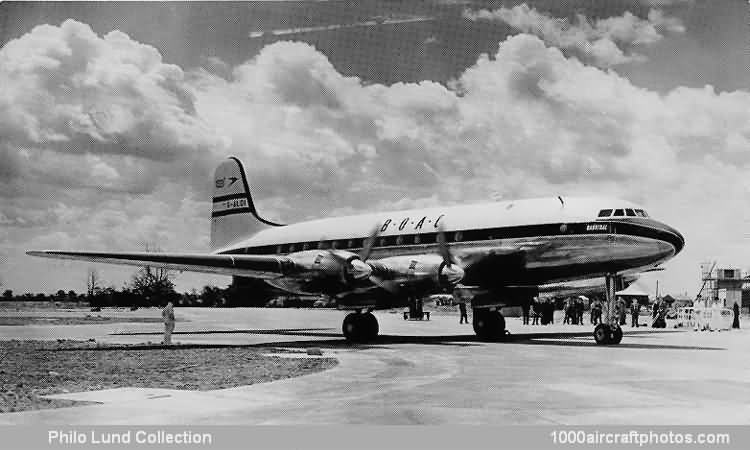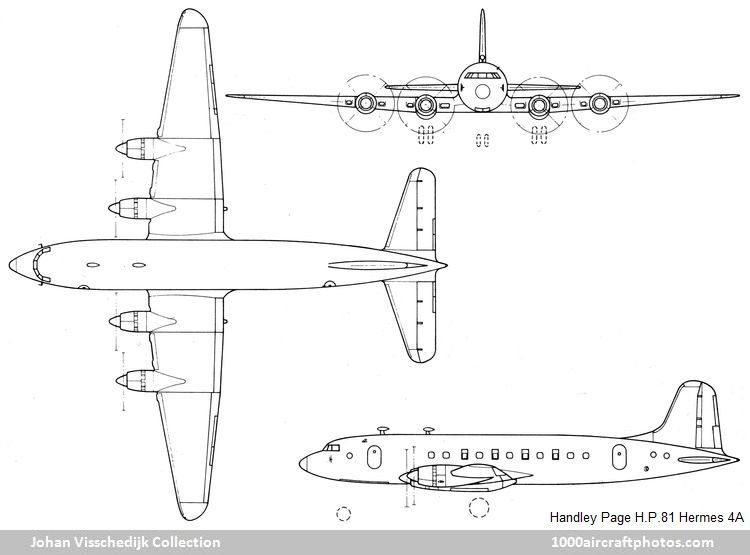01/31/2013. Remarks by Johan Visschedijk: "The H.P.68 Hermes I four-engined transport was designed during WW II for use on future peace-time air routes. A specification issued in 1944 disclosed that seven crew and either 34 first class or 50 tourist class passengers would be accommodated in a pressurized fuselage. The Hermes was thus the first British pressurized passenger aircraft.
The prototype H.P.68, registered G-AGSS, of all-metal construction powered by four Bristol Hercules engines, was built at Cricklewood during 1944-1945, and in common with all Handley Page aircraft since the H.P.42, its component parts were taken by road to Radlett Aerodrome for final erection. On Sunday December 3, 1945, the aircraft took off on its first flight piloted by Flight Lieutenant J.R. Talbot, the firm's Chief Test Pilot, but proved unmanageable, probably because of elevator overbalance, stalled and dived upside down into the ground. The pilot and flight observer E.A. Wright lost their lives and the prototype was destroyed by fire.
In spite of this set-back, work proceeded on a military counterpart, the Hastings, the first of which flew successfully during the year. A second civil prototype, the H.P.74 Hermes 2, registered G-AGUB, was then constructed and made a successful maiden flight in the hands of the company's Chief Test Pilot Squadron Leader H.G. Hazelden at Radlett on September 2, 1947, in time to participate in the SBAC Show held there a week later. It was a stretched version of the H.P.68 with a 13 ft (3.96 m) extension to the front fuselage and seating 50 passengers in pressurized comfort.
Built primarily for development flying, G-AGUB had a long and useful life which paved the way for the tricycle-landing gear version, the H.P.81 Hermes 4, 25 of which had been ordered by the Ministry of Supply on behalf of BOAC in April 1947. Construction of the first, G-AKFP, went ahead rapidly, Hazelden making the first test flight at Radlett on September 5, 1948. Such was his confidence in the new machine that before landing he flew past at an Elstree air display, and once more a new Hermes was able to put in the qualifying hours before the SBAC Show.
It was publicized as a medium-long-range type for 63 passengers and seven crew, the total payload being 15,432 lb (7,000 kg) and the ultimate range 3,500 mls (5,633 km). Its four 2,100 hp Bristol Hercules 763 power plants drove four-bladed de Havilland fully feathering, reversible-pitch airscrews and were installed in quick-access cowlings, notable for their clean aerodynamic form and beauty of line. Two such power units were installed in the outer nacelles of the Hermes 2 prototype, delivered by air to the BOAC Development Flight at Hurn on May 9, 1949 for a 250 hour program of test flying under simulated airline conditions. Its work done, the Hermes 2 returned to Radlett, where it languished until fitted with modified windows, a solar compass and camera in 1953 for geophysical research by the Ministry of Supply.
The Ministry of Supply also ordered two H.P.82 Hermes 5 development aircraft G-ALEU and G-ALEV, the first of which made its initial flight on August 23, 1949. Both Hermes 5s, exhibited at the 1949 to 1951 SBAC Shows, were powered by Bristol Theseus turbines and in their day were the world's largest prop jet aircraft. The engines, lighter than the Hercules, were installed farther forward, with the bifurcated jet orifices on each side of the nacelles and passing under the wing. Both were subjected to intensive research flying, during which G-ALEU, flown by Handley Page pilot W. Burton, ended its career in a wheels-up landing short of the Chilbolton runway in April 1951 due to engine trouble.
The second Mk. 5, G-ALEV, fully furnished to airline standards was flown the 215 mls (346 km) from London Airport, UK to Orly, Paris, France by D. Bloomfield on June 5, 1951, in the remarkable time of 43 minutes at an average speed of 300 mph (483 kmh). After demonstration to the French Authorities it returned to end its career unspectacularly under the breaker's hammer at Farnborough in 1953.
The BOAC Hermes 4s were delivered in rapid succession throughout 1950, an achievement made possible by BOAC's acceptance of a slight weight penalty resulting partly from the use of Hastings jigs and partly from the tricycle landing gear. The main oleo attachments for this were moved from the front to the rear spar, which for speed of production was strengthened by modification rather than by redesign. BOAC accepted the first aircraft on February 22, 1950, the fleet being based initially at Hurn for crew training.
After route proving trials in the June, the Hermes fleet took over the West Africa route to Kano, Lagos and Accra and later replaced the Short Solents on the route to South Africa. The Hermes thus became the first British aircraft of post-war construction to enter BOAC service. In regular airline use they carried five crew and forty passengers and perpetuated and extended the famous range of mythological names once carried by their illustrious forebears the H.P.42s.
Their career was short, and on being replaced by Canadair C-4s in 1952, G-ALDJ was fatigue checked at 3,500 hours flying time. This resulted in a program of main spar modification, after which they were cocooned at London Airport, but one did not return to suffer this humiliation. G-ALDN 'Horus', victim of a navigational error on the night of May 25 to 26, 1952, forced landed 11 hours out from Tripoli and lies under the Sahara sand in French West Africa. Several were unexpectedly recommissioned, however, when the Cornets were grounded. Fitted with 56 seats, the Hermes 4s began weekly tourist services between London, Dares Salaam and Nairobi on July 18, 1954.
The second phase in the career of the Hermes 4 began in 1952, when four were sold to Airwork Ltd. for trooping to Kenya and the Egyptian Canal Zone. The Hercules 763 engine, running on special 115 octane fuel, depended on prearranged supplies not always available in the remote areas served by charter operations. It was therefore necessary to modify the engines to burn standard 100 octane fuel, with a change in Hercules nomenclature to 773 and in aircraft designation to Hermes 4A.
The first so modified, G-ALDB, went to Entebbe for tropical trials piloted by Hazelden and the Airwork Chief Test Pilot, Captain C.D. Stenner. Fitted with 68 strengthened, rearward-facing seats and painted in military markings, the Airwork Hermes 4As plied regularly between Blackbushe and Fayid. The trooping system was later extended, and additional Hermes 4s were acquired by Airwork Ltd. for this purpose. All but one of the remainder were sold to Skyways Ltd. and Britavia Ltd., operating from Bovingdon (later Stansted) and Blackbushe respectively.
In 1954 Airwork Ltd. were successful in tendering for the Far East trooping contract to Singapore, for the carriage of 7,000 passengers each way per annum. Several aircraft were lost in this near-military operation, including G-ALDW, blown up by a saboteur's bomb on the ground at Nicosia, Cyprus, in 1956. In that year two of the Skyways aircraft, G-ALDT and G-ALDX, were detached to Middle East Airlines in Beirut, Lebanon, as OD-ADB and OD-ADC, but returned to Stansted after a few months when the pilgrim traffic subsided.
In 1957 fuel supplies were such that reversion to Hermes 4 standard took place on nearly all aircraft. The seventeen survivors continued in full employment until 1959 when Hermes 4s were transferred to a new London-Tunis service, opened by G-ALDO on June 2 and the Silver City Airways 'Silver Arrow' service between Manston and Le Touquet inaugurated by G-ALDP on June 15. At the end of the year G-ALDE and G-ALDL were converted to 78 seaters and transferred to Bahamas Airways for the Nassau-Miami route.
The pictured G-ALDI was delivered to BOAC on July 6, 1950, it was placed in storage in October 1953. In June 1954 it was sold to the charter operator Britavia Ltd. and from July 1954 it was used temporarily on behalf of the Ministry of Defence as a troop transport to Cyprus and Kenia. For political reasons it was operated as a military aircraft, with standard RAF markings and the serial XJ309. After the MoD contract had ended the aircraft was given a civil livery and carried the registration G-ALDI again. It was scrapped in October 1962."

